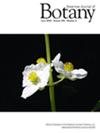Patterns of within- and among-plant variation in nectar production in the beetle-pollinated Amianthium muscaetoxicum
Abstract
Premise
Plant interactions with different pollinator species have shaped the evolution of remarkable diverse nectar production, presentation, and composition traits across the angiosperms. These traits can allow plants to manipulate and reward the behaviors of specific pollinators to enhance pollen donation and receipt with some precision. One group of animal-pollinated flowers notably lack characterizations of nectar trait diversity: plants that are pollinated by nectar-feeding beetles.
Methods
In a series of studies, we characterized variation in nectar traits within flowers, within plants, within populations and investigated the behavior of beetles feeding on nectar in a single population of the beetle-pollinated perennial monocot, Amianthium muscaetoxicum (Melanthiaceae).
Results
At the flower level, nectar accumulated throughout an individual flower's lifetime, peaking at anthesis and ceasing thereafter. Lifetime nectar production of flowers on a plant was highly consistent. At the population level, plants had high among-individual variation in nectar volume and nectar sugar concentration. Feeding experiments with a primary beetle pollinator further revealed that beetles spent significantly more time interacting with flowers with higher nectar volumes, but not flowers with higher sugar concentrations or total sugar content.
Conclusions
Our findings begin to shed light on the mutualistic interaction between Amianthium and its beetle pollinators and on the commonalities and differences between beetles and other species of nectar-feeding pollinators.





 求助内容:
求助内容: 应助结果提醒方式:
应助结果提醒方式:


